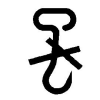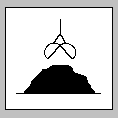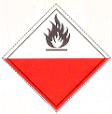| Copra | [German version] |
Table of contents |
|
| General: | ||
| Product information | ||
| Packaging | ||
| Transport | ||
| Container transport | ||
| Cargo securing | ||
Product information
Product name
| German | Kopra |
| English | Copra |
| French | Copra |
| Spanish | Copra |
| Scientific | Cocos nucifera |
| CN/HS number * | 1203 00 00 |
(* EU Combined Nomenclature/Harmonized System)
Product description
Copra is the cut, dried endosperm (nutritive tissue) of the coconut, fruit of the coconut palm from the palm family (Palmae).
Depending on the production process, a distinction is drawn between naturally dried (sun dried, more valuable) and artificially dried copra.
Quality / Duration of storage
Sun dried white copra or hot air dried white copra is of higher quality. Black, fire or kiln dried copra constitutes a lower value variety.
 Figure 1 |
Desiccated copra (broken into pieces the size of grains of rice) or copra cut into narrow strips is also of very high quality.
Care must be taken to ensure that the product has been matured and is dry for shipment. The degree to which copra is dried varies considerably, goods shipped from the Malabar coast (India) exhibit a weight loss of only approx. 3%, while the weight loss for goods from the West Indies or the Philippines may amount to 10% or more, depending on variety [11].
Before loading of the means of transport is begun, the year of harvest should be ascertained, since old, matured copra could already be rancid due to the high oil content. A certificate of origin, stating temperature and water content should be issued.
Oil content:
| 55.0 – 72.0% [1] | |
| 66.0% [11] |
Intended use
Copra is an oil-bearing raw material and is used for edible oil extraction, margarine production, cooking fats and shortenings, soap, stearin and desiccated coconut.
Figures
(Click on the Figures to enlarge them.)
Figure 2 |
 Figure 3 |
Countries of origin
This Table shows only a selection of the most important countries of origin and should not be thought of as exhaustive.
| Europe | |
| Africa | Tanzania, Ivory Coast, other countries of East Africa |
| Asia | Philippines, Indonesia, India, Sri Lanka, South Sea Islands |
| America | West Indies |
| Australia |
Back to beginning
Packaging
Copra is transported as bulk cargo or as break-bulk cargo in bags of woven natural materials (e.g. jute) or woven plastic bags.
| Marking of packages | ||
 Keep dry |
 Use no hooks |
 Keep away from heat (solar radiation) |
Back to beginning
Transport
Symbols
 General cargo |
 Bulk cargo |
 Spontaneously combustible, Class 4.2 IMDG Code |
Means of transport
Ship, truck, railroad
Container transport
Container transport is problematic, since the large amount of water vapor released, the high oil content and packaging in, for example, jute bags promote cargo fires. According to [11], limited amounts of copra may be shipped in ISO containers, in which case, however, the stowage position on board must be carefully selected so as to minimize the possibility of self-heating and to allow access to the container in the case of a cargo fire. The IMDG Code regulations must also be observed.
Cargo handling
In damp weather (rain, snow), the cargo must be protected from moisture, since it may lead to mold, spoilage and self-heating as a result of increased respiratory activity.
Hooks must not be used in handling bagged goods as they subject the cargo to point loads, so damaging the bags. Due to their shape, plate or bag hooks apply an area load and are thus more suitable for handling bags.
Stowage factor
| 2.27 m³/t (jute fabric bags, 65 kg) [1] | |
| 2.09 – 2.37 m³/t (bags) [11] | |
| 1.95 – 2.15 m³/t (bulk) [11] | |
| 2.12 – 2.27 m³/t (bags) [14] | |
| 1.84 – 2.27 m³/t (bulk) [14] | |
| 2.00 m³/t (bulk) [45] |
The stowage factor generally varies considerably, depending on the degree of drying and the size of the coconut pieces. According to [11], it is not unusual for the above-stated figures to be exceeded by up to 20%.
Stowage space requirements
Cool, dry, good ventilation.
With bagged cargo, good airing must be ensured. Stowing in two rows is recommended.
In accordance with the IMDG Code, copra must be stowed away from pipes and bulkheads which may become hot.
If copra comes into contact with the metal components of the ship, it may become rancid, for which reason the cargo should be covered with wooden dunnage, mats or jute coverings. This applies in particular to bulk shipments.
Segregation
Fiber rope, thin fiber nets
Cargo securing
Bagged cargo must be stowed and secured in the means of transport in such a manner that it cannot slip or shift during transport. If loss of volume and degradation of quality are to be avoided, the packages must not be damaged by other articles or items of cargo.
In the case of maritime transport of bulk cargo, the IMO (International Maritime Organization) „Code of Safe Practice for Solid Bulk Cargoes“ must be complied with.
Back to beginning
Risk factors and loss prevention
RF Temperature
Copra requires particular temperature, humidity/moisture and ventilation conditions (SC VII) (storage climate conditions).
Favorable travel temperature range: 5 – 25°C [1]
Temperatures > 30°C should not prevail for a long period, as self-heating may otherwise occur.
The cargo should not be stowed near sources of heat and particular not in the vicinity of oil tanks requiring heating [45].
Bags which can be shown to have undergone a considerable increase in temperature during the loading process itself must be rejected.
During the voyage, the temperature of the cargo must be measured and carefully recorded at regular intervals, so allowing the early detection of any temperature increase and the introduction of appropriate ventilation measures.
Back to beginning
RF Humidity/Moisture
Copra requires particular temperature, humidity/moisture and ventilation conditions (SC VII) (storage climate conditions).
| Designation | Humidity/water content | Source |
| Relative humidity | 70% | [1] |
| Water content | 5 – 6% | [1] |
| maximum 5% | [45] | |
| Maximum equilibrium moisture content | 70% | [1] |
Copra must be protected from all forms of moisture (seawater, rain and condensation water), since moisture promotes hydrolytic/enzymatic fat cleavage, which then results in self-heating due to increased respiration.
A water content of > 6% and excessively high relative humidities cause mold and, at an advanced stage, rotting of the cargo, which turns black and musty.
A certificate stating the water content of the cargo should be demanded from the consignor.
If copra displays green mold associated with a severe weight loss, it may be assumed that the product was shipped with too high a water content. If the mold is not associated with any weight loss, it may be supposed that the cargo has been in direct contact with water [9].
Fresh, inadequately dried copra releases large amounts of water vapor and should not therefore be stowed together with moisture-sensitive goods, such as grain, seeds, fruits, spices, tea, coffee or dried hides/furs for example.
Back to beginning
RF Ventilation
Copra requires particular temperature, humidity/moisture and ventilation conditions (SC VII) (storage climate conditions).
Recommended ventilation conditions: air exchange rate at least 10 – 20 changes/hour (airing)
With bagged cargo, good airing must be ensured, to remove water vapor and heat. Stowing in two rows is recommended.
Back to beginning
RF Biotic activity
Copra displays 3rd order biotic activity.
It is among those products in which respiration processes are suspended. Nevertheless, biochemical, microbial and other decomposition processes still proceed in such products and must be taken into consideration.
The fat decomposition which takes place during the course of hydrolytic/enzymatic fat cleavage increases the risk of the cargo undergoing self-heating, possibly ultimately resulting in a cargo fire.
Back to beginning
RF Gases
As a consequence of the decomposition processes which continue after harvest and processing, copra produces gases, such as CO2 for example, which, in particular in the case of fresh, inadequately dried goods, may lead to the build-up of life-threatening CO2 concentrations in the hold/container. Therefore, before anybody enters the hold, it must be ventilated and a gas measurement carried out. The TLV for CO2 concentration is 0.49 vol.%.
The CO content may rise from 0.002 – 0.005 vol.% (corresponding to the TLV) to 1 vol.%. The lethal limit is approx. 0.1 vol.%.
An increase in CO2 and CO content in the hold air indicates that a cargo fire has begun.
Back to beginning
RF Self-heating / Spontaneous combustion
Oil content:
| 55.0 – 72.0% [1] | |
| 66.0% [11] |
Due to its high oil content, copra has a tendency to self-heating/spontaneous combustion and is thus assigned to class 4.2 of the IMDG Code.
Copra is highly flammable: goods packaged in jute bags are deemed a particularly risky cargo, since jute material impregnated with copra oil may quickly ignite spontaneously.
Copra dust may be ignited by a single spark.
Smoking and the use of naked light sources is strictly forbidden in holds and near open hatches.
Fat decomposition in copra leads to the risk of self-heating and, finally, to a cargo fire.
Fat decomposition may proceed as follows:
| by hydrolytic/enzymatic fat cleavage or | |
| by oxidative fat cleavage |
Hydrolytic/enzymatic fat cleavage:
If the critical water content of copra is exceeded, this promotes hydrolytic/enzymatic fat cleavage. Fat-cleaving enzymes are activated by the elevated water content. The additional action of light and heat may accelerate this process. Free fatty acids sometimes have an unpleasant odor and taste. In the event of extended storage or improper cargo care, these cause the cargo to become rancid.
The self-heating of copra requires only a small seat of moisture, so that within just a few hours heating may occur at moist points for which weeks or months would be required in goods dry on shipment.
Fresh copra with a high moisture content tends rapidly towards rapid self-heating and may also ignite. Self-heating of copra leads not only to a reduction in the utility value of this product (rancid odor and taste) but also has a qualitative and quantitative effect on oil yield. The color and bleachability of the oils are also negatively affected. The oil obtained complicates refining of the crude oils in subsequent processing, because a higher free fatty acid content makes decolorization substantially more difficult.
Hydrolytic/enzymatic fat cleavage may be limited by low temperatures; however, this may only be affected to a limited degree during transport. It is therefore important to ensure storage stability by complying with the limit values for the water content of the goods.
Oxidative fat cleavage:
Food components frequently react with atmospheric oxygen in spoilage reactions. Atmospheric oxygen may enter into an addition reaction with unsaturated fatty acids through the simultaneous assistance of light, heat and certain fat companion substances, and possibly also traces of heavy metals. It is therefore absolutely essential to store copra in the dark and to protect it from oxygen and metal parts, since otherwise it becomes brown-colored and develops a rancid odor and taste.
Since the copra pieces are exposed to atmospheric oxygen to the same degree as, for instance, shelled sunflower seeds, they must not come into contact with the steel parts of the ship or with the container walls.
Back to beginning
RF Odor
| Active behavior | Copra exudes a penetrating, oily, but very pleasant odor. Due to its penetrating odor, copra should not be stowed together with odor-sensitive goods, especially not with tea. |
| Passive behavior | Copra is highly sensitive to foreign odors. |
Back to beginning
RF Contamination
| Active behavior | In the event of excessive stack pressure, heat and inadequate ventilation, copra exudes oil, which accumulates in the jute fabric of the bags, for example. The bags must not therefore be stored together with contamination-sensitive goods. Oil-impregnated jute fabric additionally greatly promotes self-heating/spontaneous combustion. |
| Passive behavior | Copra is sensitive to contamination by dust, dirt, fats and oils. The holds or containers must accordingly be clean and in a thoroughly hygienic condition before loading. Copra is sensitive to any admixture of sulfur; it must not therefore be transported with or directly after a cargo of sulfur. |
Back to beginning
RF Mechanical influences
Point loads applied for example by hooks may result in damage (tears) to the bags and thus to losses of volume. Plate or bag hooks, which, due to their shape, distribute the load and reduce the risk of damage, should thus be used.
Back to beginning
RF Toxicity / Hazards to health
The decomposition processes underway may cause life-threatening CO2 concentrations (TLV: 0.49 vol.%) or O2 shortages in the hold/container. Therefore, before anybody enters the hold, it must be ventilated and a gas measurement carried out.
Back to beginning
RF Shrinkage/Shortage
Drying-out of the cargo may cause considerable weight losses. If associated with extensive green mold, they indicate that the copra was not dry for shipment.
Depending upon variety, copra may suffer weight losses of 3 – 16% due to release of water vapor. According to [1], the following weight losses may occur:
| Name (Spanish/English) | Weight loss |
|---|---|
| copra resecada | up to 3% |
| buen corriente (good current) | up to 7% |
| corriente (current) | up to 12% |
| crudo (crude copra) | up to 16%, sometimes up to 20% |
Back to beginning
RF Insect infestation / Diseases
Sun dried copra is particularly susceptible to insect attack. Cargo must be inspected for infestation by copra beetles (copra bugs), cockroaches and other species of beetles (bacon beetle, merchant grain beetle, sawtoothed grain beetle, mites, flour beetles, meal moth, dried fruit moth). If the cargo is infested, it must be fumigated or a fumigation certificate must be demanded from the consignor.
Copra beetles (red-legged ham beetles) multiply very rapidly and infest many different types of accompanying cargoes, such as dried fruit, cocoa, expeller, desiccated coconut, as well as animal products, such as hides, skins, casings, cheese, sausage, ham and the like. Even if the cargo is not destroyed by being eaten, the beetles lay eggs in it, from which larvae shortly hatch, leaving cocoons behind.
Back to beginning
